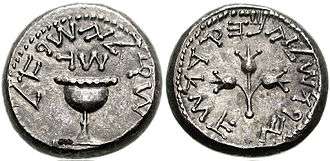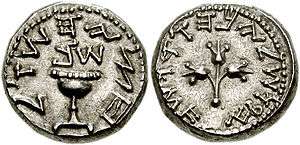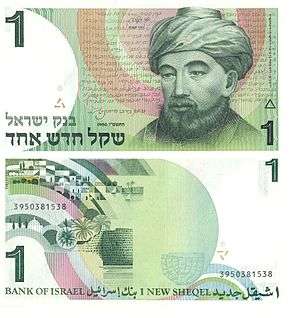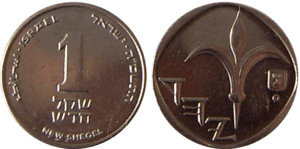Shekel
Shekel or sheqel (Phoenician: 𐤔𐤒𐤋, Hebrew: שקל, plural שקלים sheqalim or shekels; Akkadian: 𒅆𒅗𒇻 šiqlu or siqlu) is an ancient Near Eastern coin, of usually of silver. It was first a currency in ancient Tyre and ancient Carthage and then in ancient Israel under the Maccabees.

The modern currency unit used in the State of Israel today is officially known as the Israeli new shekel (Hebrew: שקל חדש, sign: ₪), which replaced the Old Israeli shekel in 1985.








Name
The word shekel is based on the Semitic verbal root for "weighing" (Š-Q-L), cognate to the Akkadian šiqlu or siqlu, a unit of weight equivalent to the Sumerian gin2.[1] Use of the word was first attested in c. 2150 BC during the Akkadian Empire under the reign of Naram-Sin, and later in c. 1700 BC in the Code of Hammurabi. The Š-Q-L root is found in the Hebrew words for "to weigh" (shaqal), "weight" (mishqal) and "consideration" (shiqqul). It is similarly related to the T-Q-L root in Aramaic and the Θ-Q-L root in Arabic, in words such as thiqal (the weight), thaqil (heavy) or Mithqal (unit of weight). The famous writing on the wall in the Biblical Book of Daniel includes a cryptic use of the word in Aramaic: "Mene, mene, teqel, u-farsin". The word shekel came into the English language via the Hebrew Bible, where it is first used in the Book of Genesis.[2]
History
The earliest shekels were a unit of weight, used as other units such as grams and troy ounces for trading before the advent of coins. The shekel was common among western Semitic peoples. Moabites, Edomites, and Phoenicians used the shekel, although proper coinage developed very late. Carthaginian coinage was based on the shekel and may have preceded its home town of Tyre in issuing proper coins.[3]
Coins were used and may have been invented by the early Anatolian traders who stamped their marks to avoid weighing each time used. Herodotus states that the first coinage was issued by Croesus, King of Lydia, spreading to the golden Daric (worth 20 sigloi or shekel),[4] issued by the Persian Empire and the silver Athenian obol and drachma. Early coins were money stamped with an official seal to certify their weight. Silver ingots, some with markings were issued. Later authorities decided who designed coins.[5]
As with many ancient units, the shekel had a variety of values depending on era, government and region; weights between 7[6] and 17 grams and values of 11,[7] 14, and 17 grams are common. When used to pay laborers, recorded wages in the ancient world range widely. The Code of Hammurabi (circa 1800 BC) sets the value of unskilled labor at approximately ten shekels per year of work.[8] Later, records within the Persian Empire (539–333 BC) give ranges from a minimum of two shekels per month for unskilled labor, to as high as seven to ten shekels per month in some records.[9] A survival wage for an urban household during the Persian period would require at least 22 shekels of income per year.[9]
Israelites
Exodus 30:24 notes that the measures of the ingredients for the holy anointing oil were to be calculated using the Shekel of the Sanctuary (see also Exodus 38:24–26, and similarly at Numbers 3:47 for payment for the redemption of 273 first-born males[10] and at Numbers 7:12–88 for the offerings of the leaders of the tribes of Israel), suggesting that there were other common measures of shekel in use, or at least that the Temple authorities defined a standard for the shekel to be used for Temple purposes.
According to Jewish law, whenever a census of the Jewish people was to be conducted, every person that was counted was required to pay the half-Shekel for his atonement (Exodus 30:11–16).[11]
The Aramaic tekel, similar to the Hebrew shekel, used in the writing on the wall during the feast of Belshazzar according to the Book of Daniel and defined as weighed, shares a common root with the word shekel and may even additionally attest to its original usage as a weight.
Second Temple period half-Shekel Temple tax

During the Second Temple period, it was customary among Jews to annually offer the half-Shekel into the Temple treasury, for the upkeep and maintenance of the Temple precincts, as also used in purchasing public animal-offerings. This practice not only applied to Jews living in the Land of Israel, but also to Jews living outside the Land of Israel.[12] Archaeological excavations conducted at Horvat 'Ethry in Israel from 1999 to 2001 by Boaz Zissu and Amir Ganor of the Israeli Antiquities Authority (IAA) have yielded important finds, the most-prized of which being a half-Shekel coin minted in the 2nd century CE, upon which are embossed the words "Half-Shekel" in paleo-Hebrew (Hebrew: חצי השקל), and which same coin possesses a silver content of 6.87 grams.[13] According to the Jewish historian Josephus, the annual monetary tribute of the half-Shekel to the Temple at Jerusalem was equivalent to two Athenian drachmæ, each Athenian or Attic drachma weighing a little over 4.3 grams.[14]
First and Second Jewish Revolt
The Jerusalem shekel was issued from AD 66 to 70 amid the First Jewish Revolt as a means of emphasizing the independence of Judaea from Roman rule.
The Bar Kochba shekel was issued from AD 132 to 135 amid the Bar Kokhba Revolt for similar reasons.
Carthage
The Carthaginian or Punic shekel was typically around 7.2 grams in silver and 7.5 grams in gold (suggesting an exchange rate of 12:1).[6] They were apparently first developed on Sicily during the mid-4th century BC.[3] They were particularly associated with the payment of Carthage's mercenary armies and were repeatedly debased over the course of each of the Punic Wars, although the Carthaginian Empire's expansion into Spain under the Barcids before the Second and recovery under Hannibal before the Third permitted improving the amount and quality of the currency. Throughout, it was more common for Carthage's holdings in North Africa to employ bronze or no coinage except when paying mercenary armies and for most of the specie to circulate in Spain, Sardinia, and Sicily.[6]
Tyre
The Tyrian shekel began to be issued c. 300 BC.[3] Owing to the relative purity of their silver, they were the preferred medium of payment for the Temple tax in Jerusalem despite their royal and pagan imagery. The money changers assaulted by Jesus in the New Testament are those who exchanged worshippers' baser common currency for such shekels and they have been suggested as a possible coin used as the "30 pieces of silver" in the New Testament.[15]
Present
Israel
The Israeli shekel (properly sheqel) replaced the Israeli lira or pound in 1980. Its currency sign was ⟨![]()
The new shekel replaced it in 1985. Its currency sign is ⟨ ₪ ⟩, although it is often denominated as ש״ח or NIS. It is subdivided into 100 agoras or agorot. Both Israeli shekels are purely units of currency and not weight. With the 2014 series of notes, the Bank of Israel abandoned the transcriptions Sheqel and Sheqalim in favor of the standard English forms Shekel and Shekels.
See also
- Ancient Mesopotamian units of measurement
- Gerah (ma'ah)
- Hanukkah gelt
- History of currency
- Israeli lira
- List of historical currencies
- Pidyon Haben ceremony
- Prutah
- Tetradrachm
- Zuz
References
Citations
- Dilke, Oswald Ashton Wentworth (1987). Mathematics and measurement. University of California Press. p. 46. Retrieved 6 February 2011.
- Genesis 23:15-16
- Bronson, Bennet (November 1976), "Cash, Cannon, and Cowrie Shells: The Nonmodern Moneys of the World", Bulletin, Vol. 47, No. 10, Chicago: Field Museum of Natural History, pp. 3–15.
- "Siglos", Encyclopædia Britannica.
- DIA 1964.
- Crawford, Michael Hewson (1985), Coinage and Money under the Roman Republic: Italy and the Mediterranean Economy, The Library of Numismatics, Berkeley: University of California Press, ISBN 0-520-05506-3
- Tenney, Merril ed., The Zondervan Pictorial Encyclopedia of the Bible, vol. 5, "Weights and Measures," Grand Rapids, MI: Zondervan, 1976.
- G. Johannes Botterweck; Helmer Ringgren; Heinz-Josef Fabry (21 June 2004). Theological Dictionary of the Old Testament. Wm. B. Eerdmans Publishing. p. 132. ISBN 978-0-8028-2345-8.
- Peter Altmann (26 October 2016). Economics in Persian-Period Biblical Texts: Their Interactions with Economic Developments in the Persian Period and Earlier Biblical Traditions. Mohr Siebeck. p. 62. ISBN 978-3-16-154813-0.
- See Bemidbar (parsha)#Sixth reading — Numbers 3:40–51
- Compare Josephus, Antiquities (vii. 13, § 1)
- Josephus, Antiquities (xviii. 9, § 1)
- Boaz Zissu & Amir Ganor, Horvat Ethri — A Jewish Village from the Second Temple Period and the Bar Kokhba Revolt in the Judean Foothills, Journal of Jewish Studies 60 (1), Oxford Centre for Hebrew and Jewish Studies, London 2009, pp. 96; 118.
- Josephus, Wars of the Jews (vii. 6, § 6).
- Wiseman, Donald J (1958), Illustrations from Biblical Archaeology, London: Tyndale Press, pp. 87–89.
Bibliography
| Wikisource has the text of the 1911 Encyclopædia Britannica article Shekel. |
| Look up shekel in Wiktionary, the free dictionary. |
| Wikimedia Commons has media related to Shekel. |
- Banknotes and coins catalog, Banking of Israel
- "Sheqel", Coins (catalog with pictures), Colnect
- Coins of the Ancient World, Detroit Institute of Arts, 1964